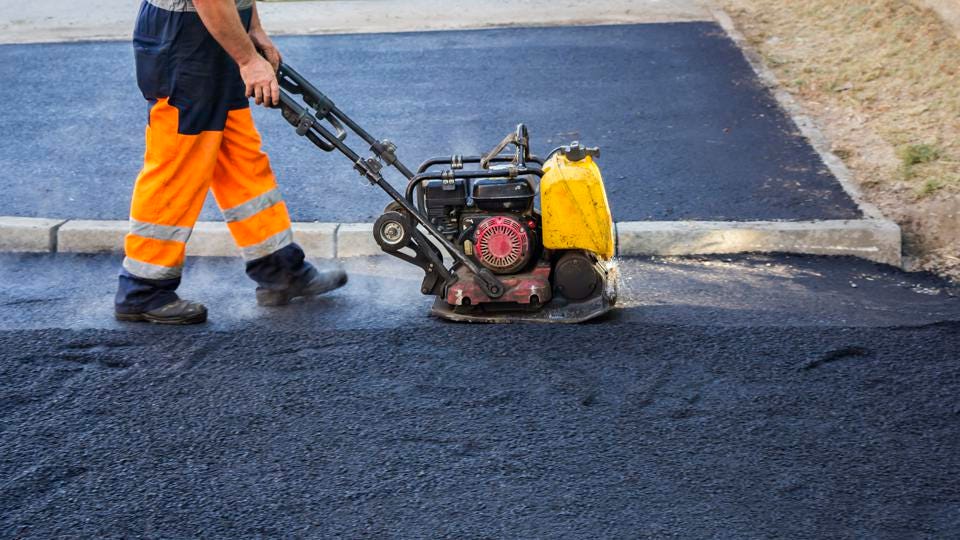Introduction:
Maintenance And Calibration Of Asphalt Pavers: Asphalt pavers play a crucial role in creating smooth and durable road surfaces, ensuring safe and comfortable journeys for all.
To maintain the efficiency and longevity of these machines, it’s essential to implement regular maintenance and calibration practices. Let’s explore some key steps to keep your asphalt paver operating at its best.

- Routine Inspections for Peak Performance:
Regular inspections are the cornerstone of asphalt paver maintenance. Conduct thorough checks of crucial components such as the engine, conveyor system, screed, and hydraulic systems. Look out for signs of wear, loose bolts, or any potential issues that could impact performance.
- Keep It Clean for Optimal Operation:
Dirt and debris can be detrimental to an asphalt paver’s functionality. Regularly clean the machine to prevent material buildup, especially in areas like the conveyors and augers. A clean paver operates more efficiently, ensuring a smoother paving process.
- Lubrication Matters:
Proper lubrication is vital for reducing friction and preventing premature wear. Follow the manufacturer’s guidelines for lubricating key components like bearings, chains, and sprockets. This simple step can significantly extend the lifespan of your asphalt paver.
- Calibration for Precision Paving:
Calibrating your asphalt paver is like tuning a musical instrument – it ensures precision and accuracy in the paving process. Pay attention to the screed, sensors, and thickness controls. Regular calibration guarantees a consistent and high-quality finish for every project.
- Tire and Track Maintenance:
Whether your asphalt paver has tires or tracks, maintaining them is crucial. Inspect for wear, ensure proper inflation or tension, and replace any damaged components promptly. Well-maintained tires or tracks contribute to stability and a smoother ride for the paver.
- Addressing Fluid Levels:
Check and maintain appropriate fluid levels, including hydraulic fluids, engine oil, and coolant. Operating with insufficient fluids can lead to overheating and damage. Regularly monitor and top up fluids to keep your asphalt paver running smoothly.
- Training and Operator Knowledge:
Ensure that operators are well-trained and knowledgeable about the specific asphalt paver model they are using. Proper operation can prevent unnecessary stress on the machine and contribute to overall longevity.
Conclusion:
Investing time and effort in the maintenance and calibration of your asphalt paver is a proactive approach to ensure consistent, high-quality results.
By following these simple yet crucial steps, you not only extend the lifespan of your equipment but also contribute to safer and more reliable road construction.
Remember, a well-maintained asphalt paver is the key to smooth and durable road surfaces that benefit everyone.
Maintenance and calibration of asphalt pavers are essential components of successful paving operations. Proper maintenance and calibration will ensure that the paving operation will produce a quality end product, with longevity and safety. Asphalt pavers are large, complex pieces of machinery. Special care and attention must be taken to maintain and calibrate the various components and service the machine regularly.
The first step in maintaining and calibrating an asphalt paver is to inspect its components, such as the rollers, conveyor belts, augers, and sprockets. These components must be free of dirt, debris, and any signs of wear or damage. Any components that are worn or damaged should be repaired, replaced, or serviced.
The second step is to check the asphalt paver’s oil levels on a regular basis and to change the oil and filter regularly according to the manufacturer’s instructions. The oil level should be at the proper level and should not contain any impurities. In addition, the oil and fuel filters should be changed regularly.
In order to calibrate the asphalt paver, it is important to measure and adjust the various components that control various functions. This includes the conveyor belt tracking, auger heights, and the grade level of the screed. It is important to ensure that all of these components are set to the appropriate settings, as outlined in the manufacturer’s instructions.
It is also important to inspect and replace any worn or damaged parts on an asphalt paver. Electric wiring should be regularly inspected for signs of damage, as well as oil and fuel hoses for leaking or deteriorated components. Any parts that are broken, worn, or otherwise damaged should be replaced in order to ensure that the asphalt paver will function safely and efficiently.
In order to ensure that the machines will operate at peak performance, asphalt pavers should also be regularly serviced. This often includes any necessary repairs, as well as regularly scheduled maintenance, such as cleaning of the parts, an engine check-up, and a lubrication cycle.
When it comes to maintenance and calibration of asphalt pavers, it is essential to follow the manufacturer’s instructions to ensure a quality end product, with longevity and safety. Proper maintenance and calibration can help ensure that the asphalt paving operation will produce the desired results.
